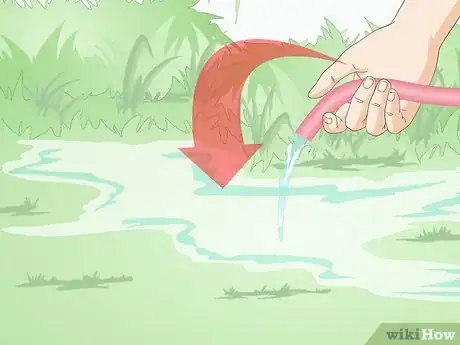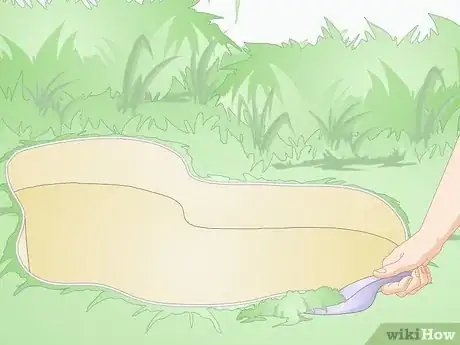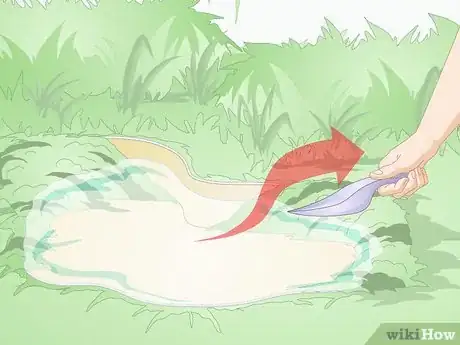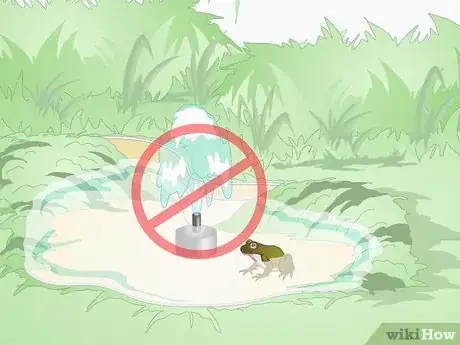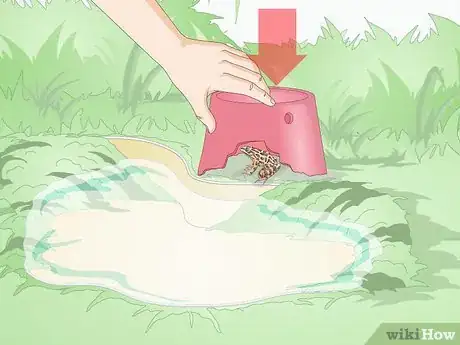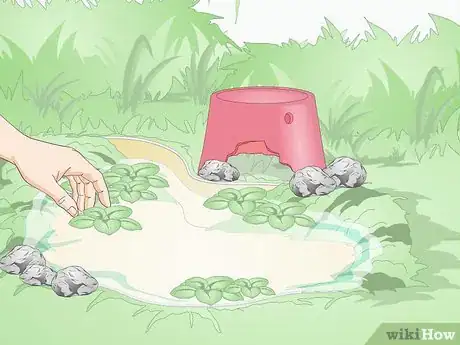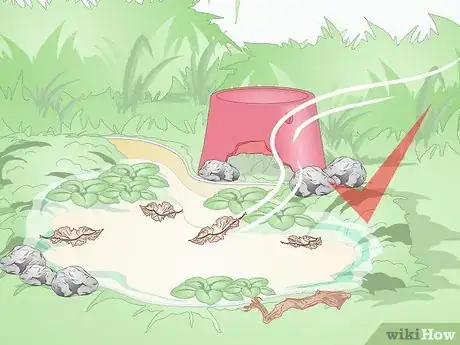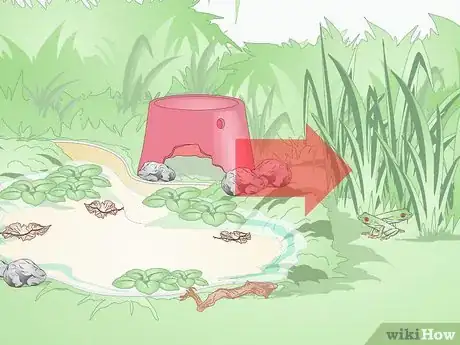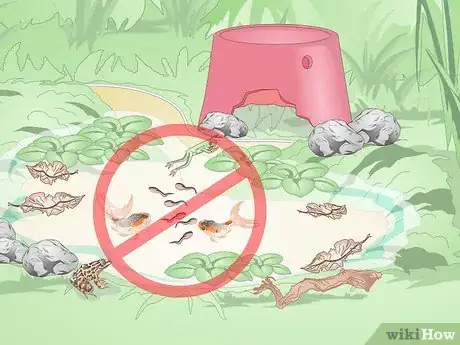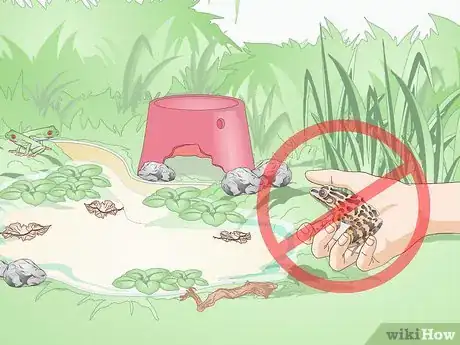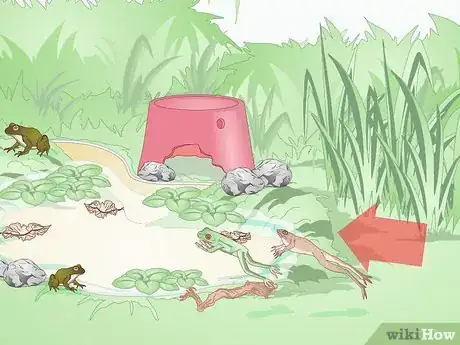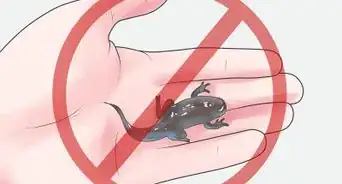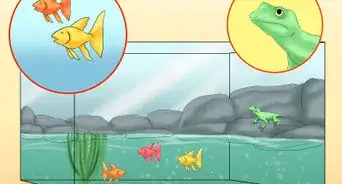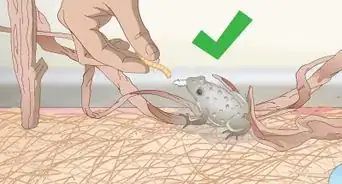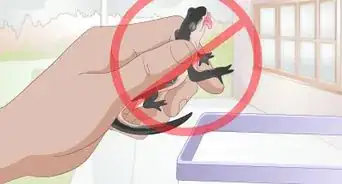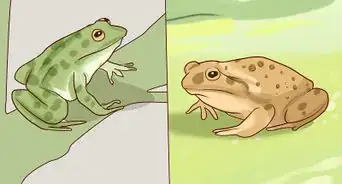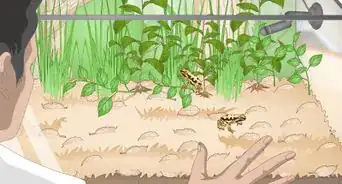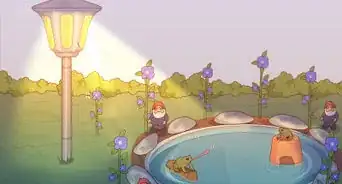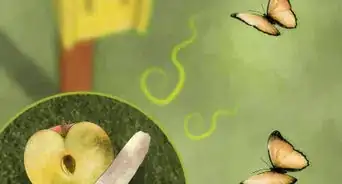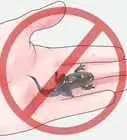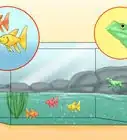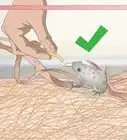This article was co-authored by Pippa Elliott, MRCVS. Dr. Elliott, BVMS, MRCVS is a veterinarian with over 30 years of experience in veterinary surgery and companion animal practice. She graduated from the University of Glasgow in 1987 with a degree in veterinary medicine and surgery. She has worked at the same animal clinic in her hometown for over 20 years.
wikiHow marks an article as reader-approved once it receives enough positive feedback. In this case, 90% of readers who voted found the article helpful, earning it our reader-approved status.
This article has been viewed 114,720 times.
Creating a frog home in your garden can add a decorative element to it or help you to create a pleasant environment thanks to the sounds of frogs croaking in the summertime. Frogs are fairly hardy animals, but they do require somewhat specific elements to keep them safe and healthy. Creating a frog home does not guarantee that frogs will take up residence in your garden, but by adhering to some specific requirements you can dramatically increase the likelihood of maintaining a population of frogs in your garden.
Steps
Providing the Frogs with a Water Source
-
1Make a water-filled area for the frogs. Frogs are amphibians, so they can live on water and land, but it’s important to remember that they require both to survive. The first step to making a frog home in your garden is providing them with a water source.[1]
- Your water source should provide both shallow and deep areas for your frogs.
- Frogs will not survive in your garden without a water source such as a small pond.
- The water area can be as small as just a few feet in diameter.
-
2Use a flexible pool liner. A flexible pool liner can allow you to create the type of water area your frogs need to survive without worrying about the water draining into the ground. Pool liners will hold the water in place and allow the water area to be replenished by rainwater.[2]
- Using a pool liner allows you to shape the water source any way that you want without worrying about leakage or erosion causing the water source to grow.
- Place rocks on the bottom of the water source for the frogs to hide within as well as to hold the liner in place.
Advertisement -
3Use alternate water sources. You may not have the space available to you to create a water source using a flexible pool liner. Frogs have been known to breed successfully in fairly small water sources, so there are a number of other options available to you.[3]
- Digging a hole for a small child’s plastic pool will hold water well. Make sure to place rocks and plants in the pool to offer higher and lower depths of water for the frogs.
- Even things as small as ice cream tubs or buckets can be used to provide frogs with still waters to hide and lay eggs.
-
4Ensure the sides aren’t too steep for frogs to jump out. The water area in your frog home should provide shallow areas that are only a few inches deep as well as a deeper area that is eight to twenty-four inches deep. Makes sure the transition from shallow to deep is gradual so frogs can make it from one to the other easily.[4]
- Make sure the sides of the deep areas aren’t too steep for a frog to be able to jump out of the water area.
- Placing a few taller rocks in the deep area can also give the frogs a jumping point in order to leave the water area or get to shallower waters.
-
5Avoid using waterfalls or fountains. While waterfalls and water fountains can be aesthetically pleasing, they may dissuade frogs from wanting to live in your garden. Frogs prefer tranquil, still waters and may avoid moving water sources.[5]
- Frogs do not require aeration devices that create moving water like many fish do, as frogs can simply come to the surface to breathe if they need more air
- Unless you intend to stock your frog home, you need to make sure your water area is alluring to frogs to lay tadpoles in. Frogs prefer still waters for laying their eggs.
Creating Shelter for the frogs
-
1Use broken planters and soil to build a frog shelter. Frogs require shelter for their safety, as they need to hide from both the sun and predators from time to time. You can make shelters out of a number of materials but broken planters are a cheap method that can be functional and pleasing to the eye.[6]
- Place broken planters on their side so the curve in the planter provides a small cave for frogs to climb under.
- Make sure the planters are near the water’s edge to give frogs quick and easy access to and from their water source.
- Put soil and plants around and on top of the planter to make it more camouflaged from predators and comfortable for frogs.
-
2Add rocks and aquatic plants to your frog home. Frogs like to have many places to sit both in and out of the water, so adding rocks and aquatic plants to your water source will give frogs a place to sit while avoiding land-based predators that may live in your garden.
- Emergent plants grow in water but rise to the surface. These are excellent in-water plants for frogs. Some examples may be reed, flowering rush, and wild rice. Aquatic flowers like duckweed are also effective.
- Plants surrounding your water source will help prevent erosion and establish a food source for your frogs through insects that take up residence in them. Good plants to place around your pond are sweet flag and swamp milkweed.
- Rocks give frogs places to hide between and under as well as a surface to rest on.
-
3Let debris remain in the water. You may be tempted to clean fallen debris out of your frog home in order to make it as pretty as possible, but that’s actually not beneficial to your frogs. Instead, leave things like fallen leaves, bird droppings, or dead insects in the water.[7]
- Fallen biological debris serves as a natural fertilizer for the pond organisms frogs usually feed on.
- Clear water can make it easier for predators to spot frogs and eat them.
-
4Leave an area near the pond un-mowed and free from chemicals. Leaving an area of tall grass near the edge of your frog home water source will give frogs increased cover from predators and offer more sources of food that your frogs can eat.[8]
- Fertilizers and insecticides can harm your frogs or prevent insects from residing in the area around your frog home. Frogs rely on insects to eat.
- Tall grass provides shade and shelter from the sun for your frogs when they aren’t in the water.
Keeping Your Frogs Healthy and Safe
-
1Keep fish out of the water source. You may begin to consider putting goldfish in the water area of your frog home in order to add another element of natural beauty to your garden, but fish are natural predators for frog eggs and tadpoles.[9]
- Fish can eliminate all of the frogs in your frog home within one generation as they eat all of the eggs and tadpoles before they grow into adulthood.
- Frogs are unlikely to leave eggs in a water area that has a large fish population for the area of water.
- Fish require significantly more water area and upkeep in your water area to maintain a surviving population.
-
2Avoid transplanting frogs into your frog home. It is not recommended that you transplant adult frogs into your frog home, as they tend not to tolerate environmental changes well and may die as a result. Tadpoles can be transplanted, but doing so can be risky to other frogs in your frog home if you aren’t sure what breed of frog the tadpoles are.[10]
- Many tadpoles that you can purchase from pet supply companies are bullfrogs. Bullfrogs can prey on other frogs and have been known to eat tadpoles, which could limit the number of frogs you can have in your frog home,
- If you choose to transplant tadpoles, it may be best to transplant them from another nearby pond or water source, as you know they can survive in the environment.
-
3Attract frogs to a new home. A better alternative to stocking your frog home is to simply make the area attractive for frogs to come to on their own. This process may take a year or two, but offers the highest survival rate as compared to stocking the frog home yourself.[11]
- Make sure your frog home and water area are safe places for frogs, otherwise even if any do come to reside in your garden they may be eaten by predators before a population can take hold. Providing adequate shelter and ensuring insects can survive in the area for frogs to feed upon is the most important element to attracting frogs.
- Having a nearby compost heap can also help encourage frogs to colonize your garden.
References
- ↑ https://www.nwf.org/News-and-Magazines/National-Wildlife/Gardening/Archives/2000/Want-to-Host-a-Garden-Party-for-Frogs.aspx
- ↑ https://www.nwf.org/News-and-Magazines/National-Wildlife/Gardening/Archives/2000/Want-to-Host-a-Garden-Party-for-Frogs.aspx
- ↑ http://www.ecolivingadvice.com/attracting-frogs-to-your-garden/
- ↑ https://www.nwf.org/News-and-Magazines/National-Wildlife/Gardening/Archives/2000/Want-to-Host-a-Garden-Party-for-Frogs.aspx
- ↑ https://www.nwf.org/News-and-Magazines/National-Wildlife/Gardening/Archives/2000/Want-to-Host-a-Garden-Party-for-Frogs.aspx
- ↑ http://www.ecolivingadvice.com/attracting-frogs-to-your-garden/
- ↑ https://www.nwf.org/News-and-Magazines/National-Wildlife/Gardening/Archives/2000/Want-to-Host-a-Garden-Party-for-Frogs.aspx
- ↑ https://www.nwf.org/News-and-Magazines/National-Wildlife/Gardening/Archives/2000/Want-to-Host-a-Garden-Party-for-Frogs.aspx
- ↑ https://www.nwf.org/News-and-Magazines/National-Wildlife/Gardening/Archives/2000/Want-to-Host-a-Garden-Party-for-Frogs.aspx
About This Article
To make a frog home in your garden, create a water source for the frogs by digging a hole, installing a pool liner, or burying a small, child-sized pool. However, make sure the sides aren’t too high for the frogs to get in and out by using rocks to create a shallow end that’s two to three inches deep. Then, create a shelter for your frogs using an old flower pot surrounded with rocks for the frogs to climb. Next, provide aquatic plants for your frog to hide under, such as swamp milkweed, duckweed, and flowering rush. For more tips, including how to attract frogs to your garden, read on!
